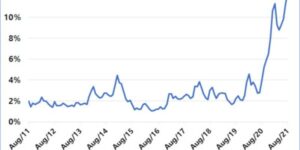On the basis of its global liner performance (GLP) and trade capacity outlook (TCO) databases, the Copenhagen-headquartered maritime consultancy Sea-Intelligence has measured the impact that congestion and vessel delays have had on the global deployed liner capacity.
At the previous height in February 2021, about 11.3% of global capacity was absorbed by delays. After a drop to 8.8% in April, the figures went up strongly over the following months. 12.5% of the global capacity – in other words, a full 3.1 million teu of nominal vessel capacity – was unavailable in August due to delays.
CEO Alan Murphy drew a parallel to the impact of the Hanjin insolvency in 2016, which “removed only 3.5% of the global capacity, and that too for only a short time, until the vessels came fully back into circulation with new owners or charterers. The current situation is therefore akin to a scenario of 3½ Hanjins all going bankrupt at the same time – with no immediate outlook for the vessels getting back at sea” in due course. Murphy expects a return to normality not before the end of 2022. (cd)



